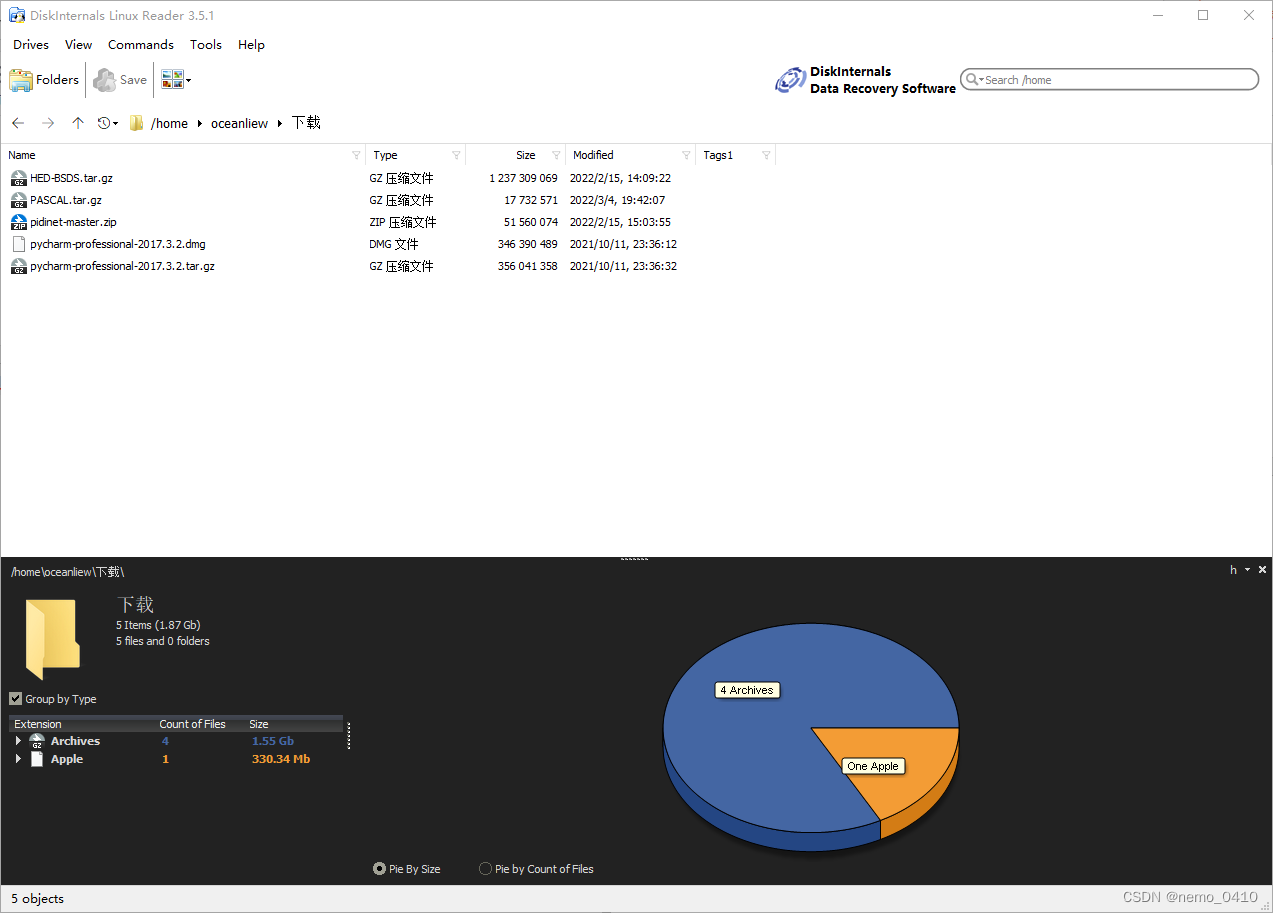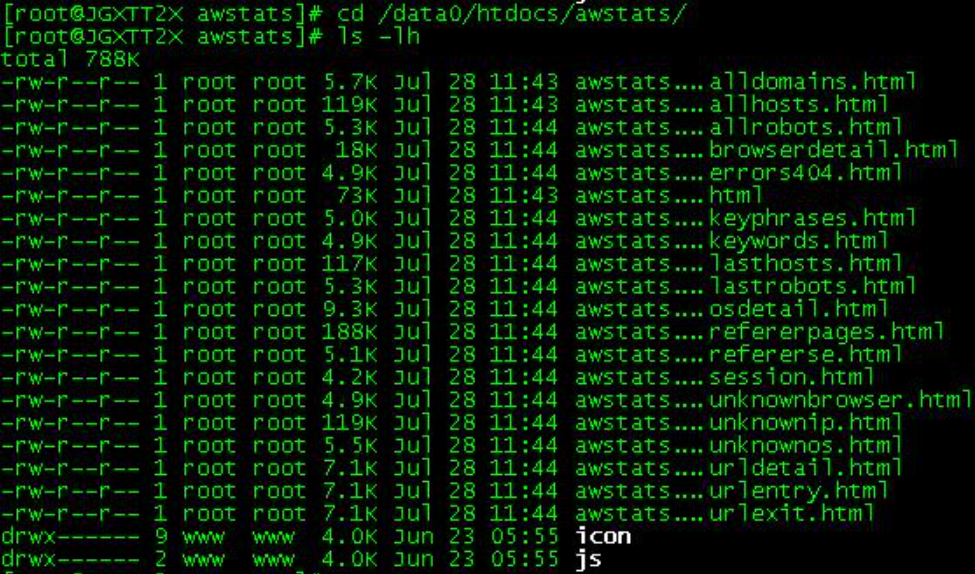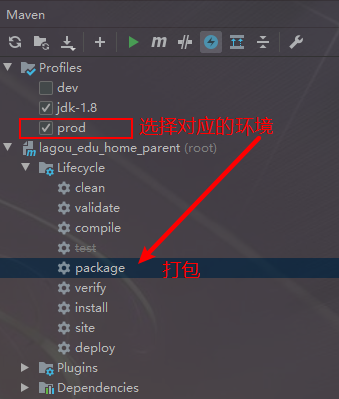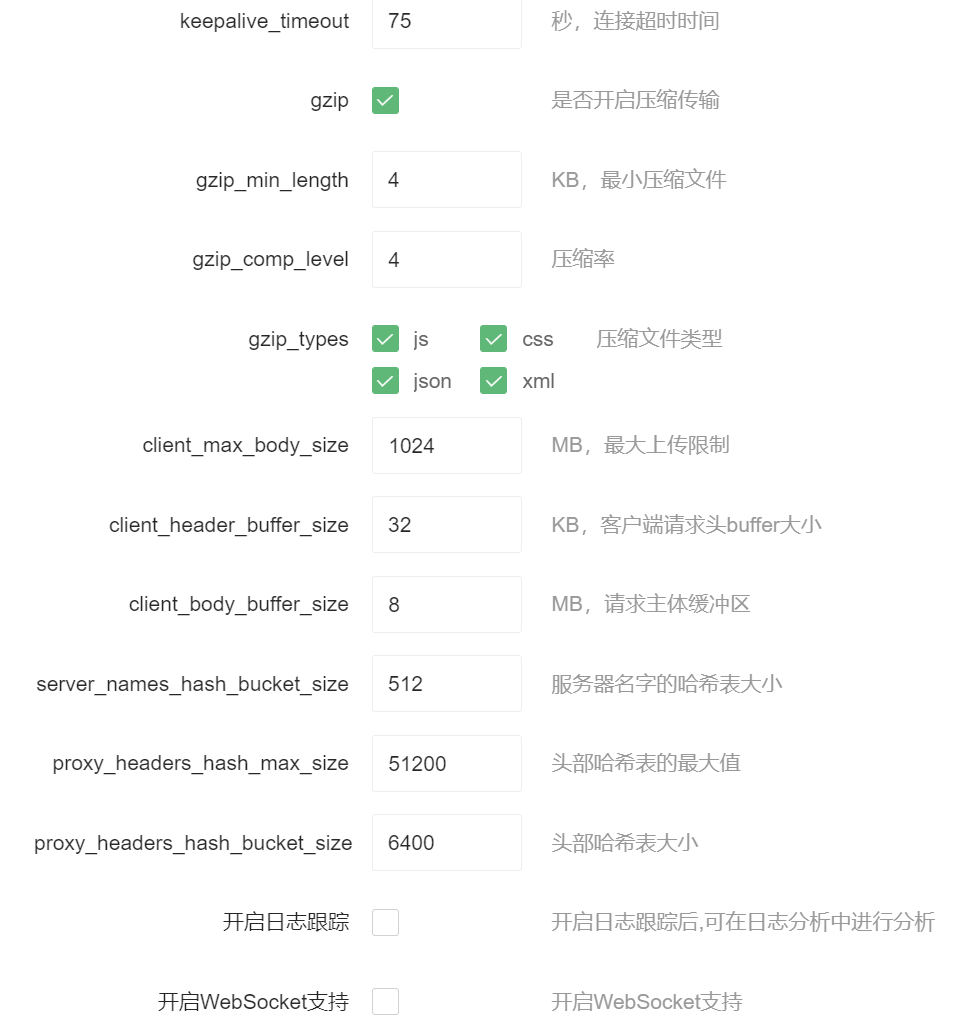- 线性回归
- 非线性模型
- MNIST手写数字识别
- 改进
- 欠拟合,过拟合
- early stop
- Dropout
- 正则化
- 梯度下降
- 批量梯度下降
- 随机梯度下降
- 小批量梯度下降
- 其他找寻最低点的方法
- 卷积神经网络
- RNN
- 模型的保存和载入
- 保存模型
- 载入模型
- 绘制神经网络的结构
1.kears官网
2.kears入门指南
我看的是AI MOOC的视频来学习kears框架。
3.keras入门视频链接
入门版视频代码链接
直接看代码是最快的入门方式,这个操作和sklearn机器学习算法基本思想还是一样的。 我觉得keras最大的优势在于Sequential,他的层可以一层一层搭建。非常形象。
线性回归
import numpy as np
np.random.seed(1337) #设置随机数种子
from keras.models import Sequential #Sequential 搭建层的函数
from keras.layers import Dense
import matplotlib.pyplot as plt
# 创建数据集
X = np.linspace(-1, 1, 200)
np.random.shuffle(X) # 将数据集随机化
Y = 0.5 * X + 2 + np.random.normal(0, 0.05, X.shape) # 假设我们真实模型为:Y=0.5X+2
# 绘制数据集plt.scatter(X, Y) #生成X,Y的散点图
plt.show()
X_train, Y_train = X[:160], Y[:160] # 把前160个数据放到训练集
X_test, Y_test = X[160:], Y[160:] # 把后40个点放到测试集
# 定义一个model,
model = Sequential () # Keras有两种类型的模型,序贯模型(Sequential)和函数式模型
# 比较常用的是Sequential,它是单输入单输出的
model.add(Dense(1, input_dim=1)) # 通过add()方法一层层添加模型
# Dense是全连接层,第一层需要定义输入,
# 第二层无需指定输入,一般第二层把第一层的输出作为输入
# 定义完模型就需要训练了,不过训练之前我们需要指定一些训练参数
# 通过compile()方法选择损失函数和优化器
# 这里我们用均方误差作为损失函数,随机梯度下降作为优化方法
model.compile(loss='mse', optimizer='sgd')
# 开始训练
print('Training -----------')
for step in range(301):
cost = model.train_on_batch(X_train, Y_train) # Keras有很多开始训练的函数,这里用train_on_batch()
if step % 100 == 0:
print('train cost: ', cost)
# 测试训练好的模型
print('\nTesting ------------')
cost = model.evaluate(X_test, Y_test, batch_size=40)
print('test cost:', cost)
W, b = model.layers[0].get_weights() # 查看训练出的网络参数
# 由于我们网络只有一层,且每次训练的输入只有一个,输出只有一个
# 因此第一层训练出Y=WX+B这个模型,其中W,b为训练出的参数
print('Weights=', W, '\nbiases=', b)
# plotting the prediction
Y_pred = model.predict(X_test)
plt.scatter(X_test, Y_test)
plt.plot(X_test, Y_pred)
plt.show()
得到的输出
test cost: 0.0038014401216059923
Weights= [[0.43543226]]
biases= [1.9983047]
我们实际的曲线为 Y = 0.5 * X + 2 我们预测出来的w=0.435,b=1.99, w相差比较大。所以这个模型并不是很好。可以调整循环次数来提高正确率。
非线性模型
import keras
import numpy as np
import matplotlib.pyplot as plt
# Sequential按顺序构成的模型
from keras.models import Sequential
# Dense全连接层
from keras.layers import Dense,Activation
from keras.optimizers import SGD
# 使用numpy生成200个随机点
x_data = np.linspace(-0.5,0.5,200)
noise = np.random.normal(0,0.02,x_data.shape)
y_data = np.square(x_data) + noise
# 显示随机点
plt.scatter(x_data,y_data)
plt.show()
# 构建一个顺序模型
model = Sequential()
# 在模型中添加一个全连接层
# 1-10-1
model.add(Dense(units=10,input_dim=1,activation='tanh')) #如果没有激活函数的话,不能实现非线性。
# model.add(Activation('tanh')) #另一种添加激活函数层的方法
model.add(Dense(units=1,activation='tanh'))
# model.add(Activation('tanh'))
# 定义优化算法
sgd = SGD(lr=0.2) #更改SGD的步长
# sgd:Stochastic gradient descent,随机梯度下降法
# mse:Mean Squared Error,均方误差
model.compile(optimizer=sgd,loss='mse')
# 训练3001个批次
for step in range(6001):
# 每次训练一个批次
cost = model.train_on_batch(x_data,y_data)
# 每500个batch打印一次cost值
if step % 500 == 0:
print('cost:',cost)
# x_data输入网络中,得到预测值y_pred
y_pred = model.predict(x_data)
# 显示随机点
plt.scatter(x_data,y_data)
# 显示预测结果
plt.plot(x_data,y_pred,'r-',lw=3)
plt.show()
MNIST手写数字识别
# _*_ coding: utf-8 _*_
# Classifier mnist
import numpy as np
np.random.seed(1337)
from keras.datasets import mnist
from keras.utils import np_utils
from keras.models import Sequential
from keras.layers import Dense, Activation
from keras.optimizers import RMSprop
# 下载数据集
(X_train, y_train), (X_test, y_test) = mnist.load_data()
# 数据预处处理,训练集归一化, 测试集转换成one-hot形式。
#原本shape是[60000,28,28],现在要转成[60000,784], X_train.shape[0]=60000, 后面的参数=-1的话,则就是把后面的两个参数大小相乘。
X_train = X_train.reshape(X_train.shape[0], -1) / 255. #
X_test = X_test.reshape(X_test.shape[0], -1) / 255.
y_train = np_utils.to_categorical(y_train, num_classes=10)
y_test = np_utils.to_categorical(y_test, num_classes=10)
# 不使用model.add(),用以下方式也可以构建网络
# 一定到位,不用一行一行的添加
model = Sequential([
Dense(400, input_dim=784),#输入维度784, 输出维度400
Activation('relu'),
Dense(10), #只有第一层需要填写上输入的维度,后面只需要填写上输出的维度。
Activation('softmax'),
])
# 定义优化器
# 定义优化器
sgd = SGD(lr=0.2)
model.compile(optimizer=sgd,
loss='mse',
metrics=['accuracy']) # metrics赋值为'accuracy',会在训练过程中输出正确率
# 这次我们用fit()来训练网路
print('Training ------------')
model.fit(X_train, y_train, epochs=4, batch_size=32)
print('\nTesting ------------')
# 评价训练出的网络
loss, accuracy = model.evaluate(X_test, y_test)
print('test loss: ', loss)
print('test accuracy: ', accuracy)
最后的准确度:
test loss 0.01301875151693821
accuracy 0.917900025844574
准确度只有0.917,精度不是很高。
改进
-
1.改变损失函数 损失函数的选择: 如果输出是线性回归模型,损失函数使用二次代价函数;
-
2.如果输出是S型函数,那么比较适合使用交叉熵代价函数;(交叉熵损失函数经常用于分类问题中,特别是在神经网络做分类问题时,也经常使用交叉熵作为损失函数,此外,由于交叉熵涉及到计算每个类别的概率,所以交叉熵几乎每次都和sigmoid(或softmax)函数一起出现。)
-
3.如果输出是softmax函数,使用对数代价函数。
因为这个是分类问题,所以可以试试使用交叉熵作为损失函数。改一下优化器的损失函数即可。
# 定义优化器,loss function,训练过程中计算准确率
model.compile(
optimizer = sgd,
loss = 'categorical_crossentropy',
metrics=['accuracy'],
)
最后的准确度:
test loss 0.2678716778755188
accuracy 0.9243999719619751
相比于之前的mse均方误差准确度有所提升。
欠拟合,过拟合

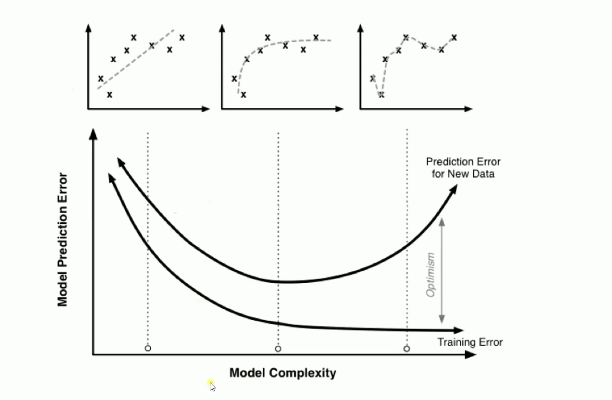 这里就不在赘述这部分内容了。
这里就不在赘述这部分内容了。
过拟合的解决方法: 1.dropout
2.增加数据集
3.early stopping(看上面第二幅图,我们训练到中间那里的时候,就是最好的状态,再训练下去模型越来越差)
4.正则化
early stop
-
在训练模型的时候,我们往往会设置一个比较大的迭代次数。Early stopping便是一种提前结束训练的策略用来防止过拟合。
-
一般的做法是记录到目前为止最好的 validation accuracy,当连续10个Epoch没有达到最佳 accuracy时,则可以认为 accuracy不再提高了。此时便可以停止迭代了(Early Stopping)。
体验神经网络训练,可以参考:可以明白各个参数的含义。 
1.A neural network playground
2.回形针paperclip视频
Dropout
1.没有加Dropout
import numpy as np
from keras.datasets import mnist
from keras.utils import np_utils
from keras.models import Sequential
from keras.layers import Dense,Dropout
from keras.optimizers import SGD
# 载入数据
(x_train,y_train),(x_test,y_test) = mnist.load_data()
# (60000,28,28)
print('x_shape:',x_train.shape)
# (60000)
print('y_shape:',y_train.shape)
# (60000,28,28)->(60000,784)
x_train = x_train.reshape(x_train.shape[0],-1)/255.0
x_test = x_test.reshape(x_test.shape[0],-1)/255.0
# 换one hot格式
y_train = np_utils.to_categorical(y_train,num_classes=10)
y_test = np_utils.to_categorical(y_test,num_classes=10)
# 创建模型
model = Sequential([
Dense(units=200,input_dim=784,bias_initializer='one',activation='tanh'),
Dense(units=100,bias_initializer='one',activation='tanh'),
Dense(units=10,bias_initializer='one',activation='softmax')
])
# 定义优化器
sgd = SGD(lr=0.2)
# 定义优化器,loss function,训练过程中计算准确率
model.compile(
optimizer = sgd,
loss = 'categorical_crossentropy',
metrics=['accuracy'],
)
# 训练模型
model.fit(x_train,y_train,batch_size=32,epochs=10)
# 评估模型
loss,accuracy = model.evaluate(x_test,y_test)
print('\ntest loss',loss)
print('test accuracy',accuracy)
loss,accuracy = model.evaluate(x_train,y_train)
print('train loss',loss)
print('train accuracy',accuracy)
输出的准确度:
test loss 0.07081281393766403
test accuracy 0.9785000085830688
1875/1875 [==============================] - 3s 2ms/step - loss: 0.0076 - accuracy: 0.9987
train loss 0.007551191840320826
train accuracy 0.9987166523933411
面对复杂的模型,train accuracy 和 test accuracy相差很大。过拟合现象严重,所以需要加入Dropout层降低过拟合现象。
只需要在层结构中,加入Dropout层即可。
model = Sequential([
Dense(units=200,input_dim=784,bias_initializer='one',activation='tanh'),
Dropout(0.4), #每一次让40%的神经元正常工作
Dense(units=100,bias_initializer='one',activation='tanh'),
Dropout(0.4),
Dense(units=10,bias_initializer='one',activation='softmax')
])
输出的准确率:
test loss 0.10333003848791122
test accuracy 0.9700999855995178
train loss 0.07441262900829315
train accuracy 0.9776166677474976
我们可以看到加入dropout层后,它的精度可能还会下降。但过拟合的现象会好点。
正则化
import numpy as np
from keras.datasets import mnist
from keras.utils import np_utils
from keras.models import Sequential
from keras.layers import Dense
from keras.optimizers import SGD
from keras.regularizers import l2
# 载入数据
(x_train,y_train),(x_test,y_test) = mnist.load_data()
# (60000,28,28)
print('x_shape:',x_train.shape)
# (60000)
print('y_shape:',y_train.shape)
# (60000,28,28)->(60000,784)
x_train = x_train.reshape(x_train.shape[0],-1)/255.0
x_test = x_test.reshape(x_test.shape[0],-1)/255.0
# 换one hot格式
y_train = np_utils.to_categorical(y_train,num_classes=10)
y_test = np_utils.to_categorical(y_test,num_classes=10)
# 创建模型
model = Sequential([
Dense(units=200,input_dim=784,bias_initializer='one',activation='tanh',kernel_regularizer=l2(0.0003)),
Dense(units=100,bias_initializer='one',activation='tanh',kernel_regularizer=l2(0.0003)),
Dense(units=10,bias_initializer='one',activation='softmax',kernel_regularizer=l2(0.0003))
])
"""
Dense的参数
Dense (self,
units,
activation=None,
use_bias=True,
kernel_initializer='glorot_uniform',
bias_initializer='zeros',
kernel_regularizer=None,
bias_regularizer=None,
activity_regularizer=None,
kernel_constraint=None,
bias_constraint=None,
**kwargs):
Dense里面有正则化的参数。kernel_regularizer默认是None. 现在使用l2正则化,kernel_regularizer=l2(0.0003)里面的数值为正则化系数。
"""
# 定义优化器
sgd = SGD(lr=0.2)
# 定义优化器,loss function,训练过程中计算准确率
model.compile(
optimizer = sgd,
loss = 'categorical_crossentropy',
metrics=['accuracy'],
)
# 训练模型
model.fit(x_train,y_train,batch_size=32,epochs=10)
# 评估模型
loss,accuracy = model.evaluate(x_test,y_test)
print('\ntest loss',loss)
print('test accuracy',accuracy)
loss,accuracy = model.evaluate(x_train,y_train)
print('train loss',loss)
print('train accuracy',accuracy)
梯度下降
这部分内容参考回形针的视频
批量梯度下降
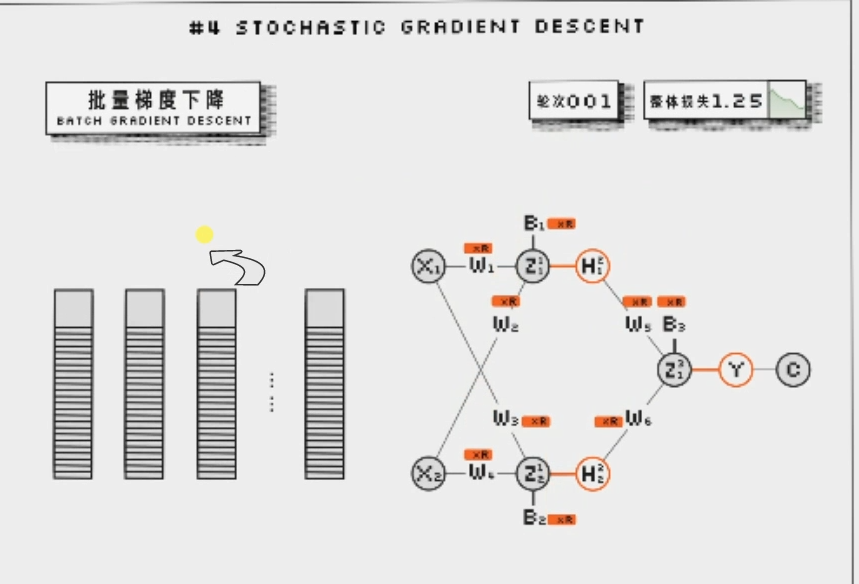 批量梯度下降,计算所有节点的偏导数,然后求平均,乘上步长。更新一次参数。如果有1000个点输入,就遍历1000个点,求出各个节点的导数,求平均再乘上步长,然后更新一次参数。这个方法的缺点就是输入数据太多的话,一次迭代就需要计算很长时间。
批量梯度下降,计算所有节点的偏导数,然后求平均,乘上步长。更新一次参数。如果有1000个点输入,就遍历1000个点,求出各个节点的导数,求平均再乘上步长,然后更新一次参数。这个方法的缺点就是输入数据太多的话,一次迭代就需要计算很长时间。
随机梯度下降
为了提高速度,因此提出了随机梯度下降。每次只针对一个样本更新参数。从输入样本数据中,随机选取一个数据,然后就更新w参数。这样虽然速度提高了,而且也能避免结果卡在局部最低点。但是这样可能找到全局最低点的效率比较慢;
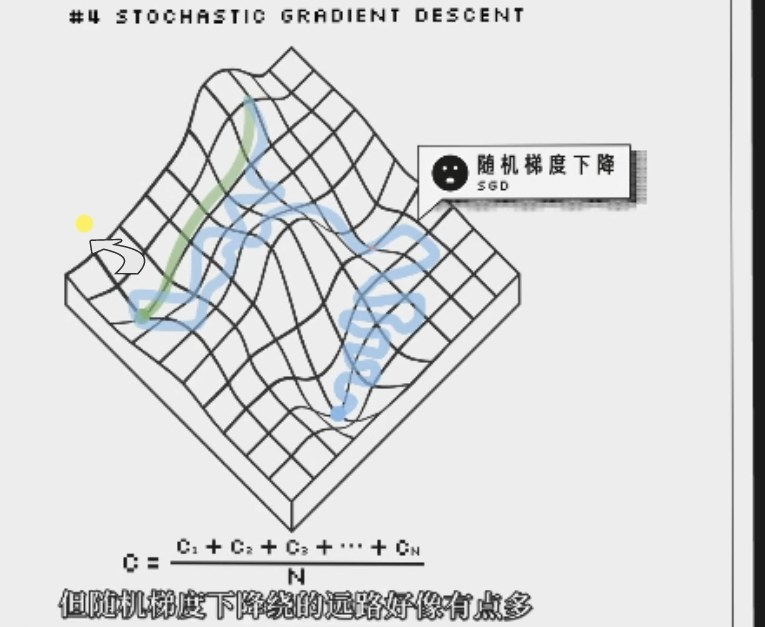
小批量梯度下降
每次从输入样本中提取出一个batch出来更新参数,这个就叫做小批量梯度下降。
其他找寻最低点的方法
梯度下降找寻函数最低点是我们听的比较多的方法。其实还有很多方法去找到函数的最低点,比如SGD,Momentum,NAG,Adagrad,等等方法
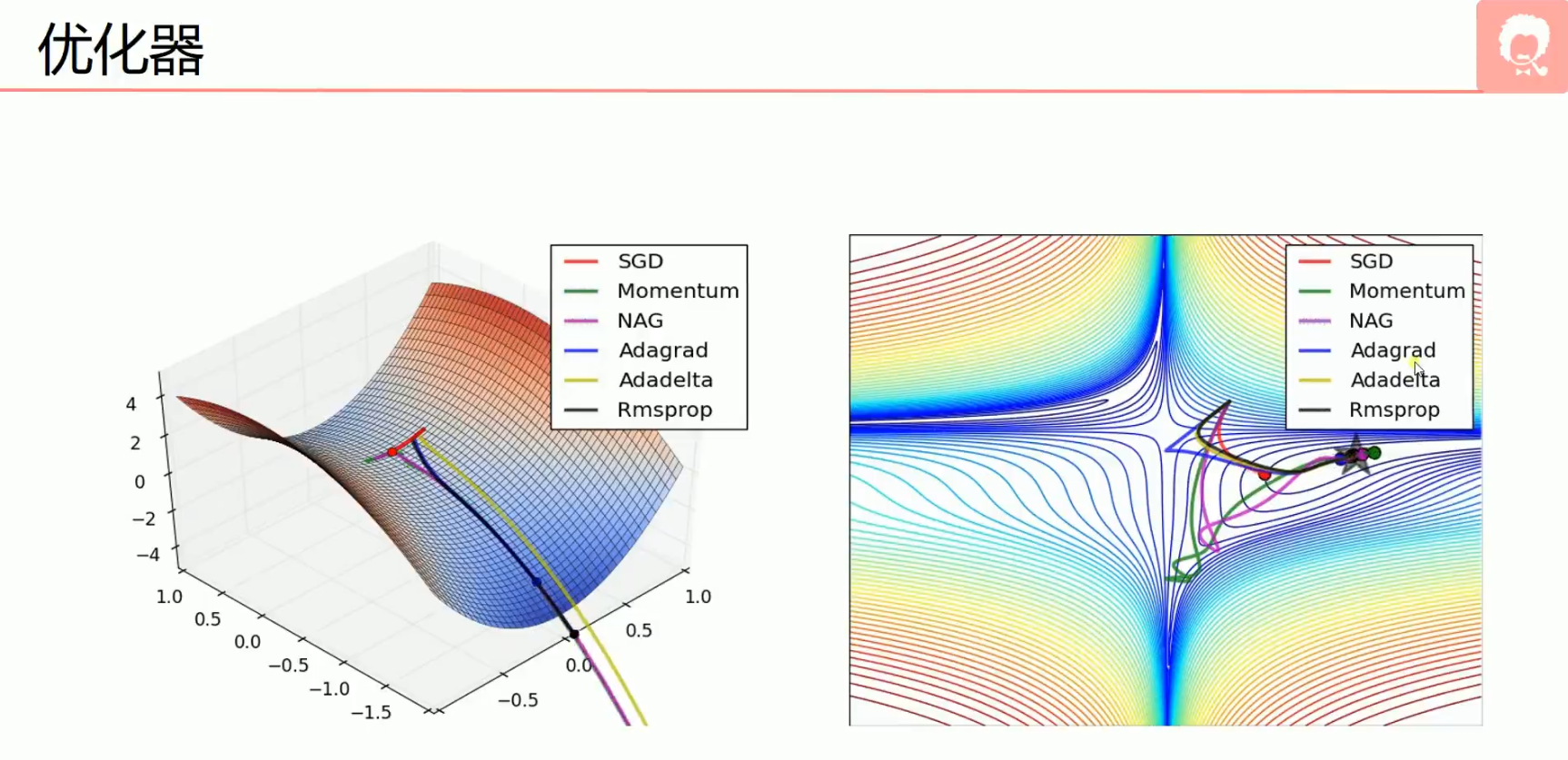
我们一般实际中,使用比较多的是SGD梯度下降法和自适应矩估计Adam优化器. 和SGD代码不同的地方就是优化器那里改一改就行了
from keras.optimizers import SGD,Adam
adam = Adam(lr=0.001)
# 定义优化器,loss function,训练过程中计算准确率
model.compile(
optimizer = adam,
loss = 'categorical_crossentropy',
metrics=['accuracy'],
)
卷积神经网络
图像一般使用卷积神经网络。CNN可以通过局部感受野和权重共享减少网络参数的个数,前面的代码中,都没有出现卷积核,池化做这些操作。所以都是全链接,因此他的参数超级多,如果面对一个一层网络中,有很多节点的网络,训练起来就很慢。
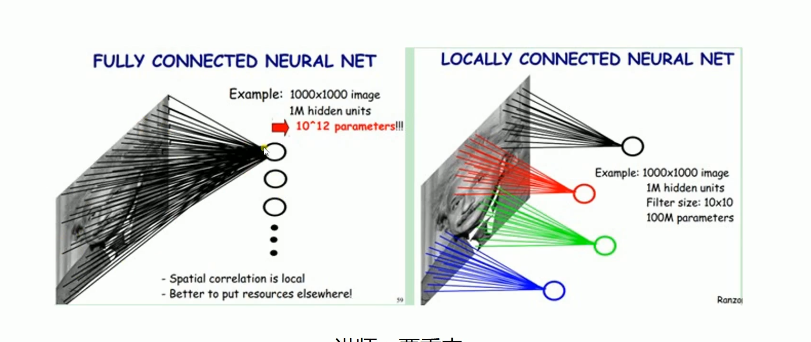
基本卷积网络体验可以参考 3D visualization 可以自己去体验一下。 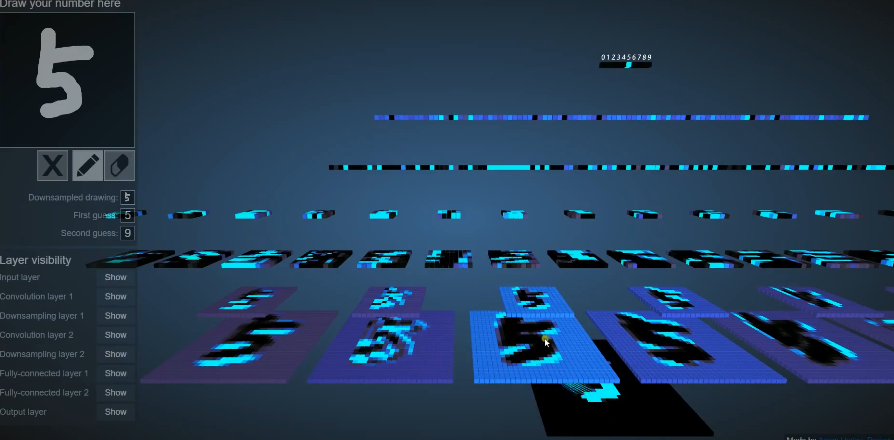
案例:CNN应用于手写数字识别
import numpy as np
from keras.datasets import mnist
from keras.utils import np_utils
from keras.models import Sequential
from keras.layers import Dense,Dropout,Convolution2D,MaxPooling2D,Flatten
from keras.optimizers import Adam
# 载入数据
(x_train,y_train),(x_test,y_test) = mnist.load_data()
# (60000,28,28)->(60000,28,28,1) 60000个数据,28*28,深度为1
x_train = x_train.reshape(-1,28,28,1)/255.0 #-1能够自动匹配,
x_test = x_test.reshape(-1,28,28,1)/255.0
# 换one hot格式
y_train = np_utils.to_categorical(y_train,num_classes=10)
y_test = np_utils.to_categorical(y_test,num_classes=10)
# 定义顺序模型
model = Sequential()
# 第一个卷积层
# input_shape 输入平面
# filters 卷积核/滤波器个数
# kernel_size 卷积窗口大小
# strides 步长
# padding padding方式 same/valid
# activation 激活函数
model.add(Convolution2D(
input_shape = (28,28,1),
filters = 32,
kernel_size = 5,
strides = 1,
padding = 'same',
activation = 'relu'
))
# 第一个池化层
model.add(MaxPooling2D(
pool_size = 2,
strides = 2,
padding = 'same',
))
# 第二个卷积层
model.add(Convolution2D(64,5,strides=1,padding='same',activation = 'relu'))
#像64,5这样的,按照convolution2D这个函数形参顺序传入
# 第二个池化层
model.add(MaxPooling2D(2,2,'same'))
# 把第二个池化层的输出扁平化为1维
model.add(Flatten())
# 第一个全连接层
model.add(Dense(1024,activation = 'relu'))
# Dropout
model.add(Dropout(0.5))
# 第二个全连接层
model.add(Dense(10,activation='softmax'))
# 定义优化器
adam = Adam(lr=1e-4)
# 定义优化器,loss function,训练过程中计算准确率
model.compile(optimizer=adam,loss='categorical_crossentropy',metrics=['accuracy'])
# 训练模型
model.fit(x_train,y_train,batch_size=64,epochs=10)
# 评估模型
loss,accuracy = model.evaluate(x_test,y_test)
print('test loss',loss)
print('test accuracy',accuracy)
最后的识别精度:
test loss 0.02161419950425625
test accuracy 0.9929999709129333
达到了99%,而且keras这个CNN代码很有画面感,一层一层自己加上去。
RNN
如语音输入,他的输出需要关联上之前的输出,因此有了RNN,将前一次的状态当作输入,作为下一次的输入; 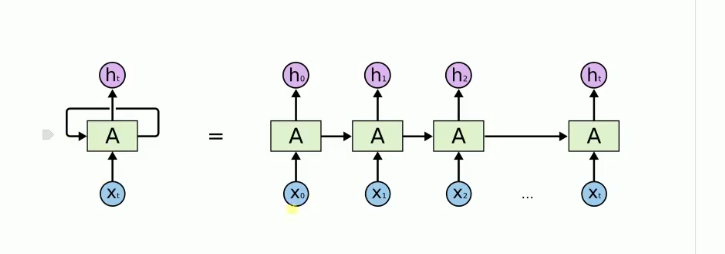
import numpy as np
from keras.datasets import mnist
from keras.utils import np_utils
from keras.models import Sequential
from keras.layers import Dense
from keras.layers.recurrent import SimpleRNN
from keras.optimizers import Adam
# 数据长度-一行有28个像素
input_size = 28
# 序列长度-一共有28行
time_steps = 28
# 隐藏层cell个数
cell_size = 50
# 载入数据
(x_train,y_train),(x_test,y_test) = mnist.load_data()
# (60000,28,28)
x_train = x_train/255.0
x_test = x_test/255.0
# 换one hot格式
y_train = np_utils.to_categorical(y_train,num_classes=10)
y_test = np_utils.to_categorical(y_test,num_classes=10)#one hot
# 创建模型
model = Sequential()
# 循环神经网络
model.add(SimpleRNN(
units = cell_size, # 输出
input_shape = (time_steps,input_size), #输入
))
# 输出层
model.add(Dense(10,activation='softmax'))
# 定义优化器
adam = Adam(lr=1e-4)
# 定义优化器,loss function,训练过程中计算准确率
model.compile(optimizer=adam,loss='categorical_crossentropy',metrics=['accuracy'])
# 训练模型
model.fit(x_train,y_train,batch_size=64,epochs=10)
# 评估模型
loss,accuracy = model.evaluate(x_test,y_test)
print('test loss',loss)
print('test accuracy',accuracy)
最后输出的准确度:
test loss 0.3422239124774933
test accuracy 0.9006999731063843
这个只是例子,RNN不太适合用于分类之中,所以这里的进度并不是很高。
模型的保存和载入
保存模型
#这个导入用于保存网络结构的函数
from keras.models import model_from_json
# 在代码的最后写上
model.save('model.h5') # HDF5文件,pip install h5py
# 只保存网络的参数
model.save_weights('my_model_weights.h5')
# 保存网络结构
json_string = model.to_json()
即可保存整个网络的模型,参数和网络结构
载入模型
#载入模型的参数和网络结构。
model = load_model('model.h5')
#只载入网络的参数
model.load_weights('my_model_weights.h5')
#载入网络结构
model = model_from_json(json_string)
绘制神经网络的结构
示例代码
import numpy as np
from keras.datasets import mnist
from keras.utils import np_utils
from keras.models import Sequential
from keras.layers import Dense,Dropout,Convolution2D,MaxPooling2D,Flatten
from keras.optimizers import Adam
from keras.utils.vis_utils import plot_model
import matplotlib.pyplot as plt
# 载入数据
(x_train,y_train),(x_test,y_test) = mnist.load_data()
# (60000,28,28)->(60000,28,28,1)
x_train = x_train.reshape(-1,28,28,1)/255.0
x_test = x_test.reshape(-1,28,28,1)/255.0
# 换one hot格式
y_train = np_utils.to_categorical(y_train,num_classes=10)
y_test = np_utils.to_categorical(y_test,num_classes=10)
# 定义顺序模型
model = Sequential()
# 第一个卷积层
# input_shape 输入平面
# filters 卷积核/滤波器个数
# kernel_size 卷积窗口大小
# strides 步长
# padding padding方式 same/valid
# activation 激活函数
model.add(Convolution2D(
input_shape = (28,28,1),
filters = 32,
kernel_size = 5,
strides = 1,
padding = 'same',
activation = 'relu',
name = 'conv1'
))
# 第一个池化层
model.add(MaxPooling2D(
pool_size = 2,
strides = 2,
padding = 'same',
name = 'pool1'
))
# 第二个卷积层
model.add(Convolution2D(64,5,strides=1,padding='same',activation = 'relu',name='conv2'))
# 第二个池化层
model.add(MaxPooling2D(2,2,'same',name='pool2'))
# 把第二个池化层的输出扁平化为1维
model.add(Flatten())
# 第一个全连接层
model.add(Dense(1024,activation = 'relu'))
# Dropout
model.add(Dropout(0.5))
# 第二个全连接层
model.add(Dense(10,activation='softmax'))
# # 定义优化器
# adam = Adam(lr=1e-4)
# # 定义优化器,loss function,训练过程中计算准确率
# model.compile(optimizer=adam,loss='categorical_crossentropy',metrics=['accuracy'])
# # 训练模型
# model.fit(x_train,y_train,batch_size=64,epochs=1)
# # 评估模型
# loss,accuracy = model.evaluate(x_test,y_test)
# print('test loss',loss)
# print('test accuracy',accuracy)
plot_model(model,to_file="model.png",show_shapes=True,show_layer_names=True,rankdir='TB') #TB表示从上到下,LR表示从左到右
plt.figure(figsize=(10,10))
img = plt.imread("model.png")
plt.imshow(img)
plt.axis('off')
plt.show()
在运行代码之前,需要先安装pydot and graphviz,我安装的时候就出现了问题。安装后也还是不能用,解决方法: 画网络结构图安装了pydot和graphviz出现Failed to import pydot. You must pip install pydot and install graph错误
解决方法:
conda install graphviz
conda install pydotplus
pip install pydot
打开cmd,进入虚拟环境,按顺序安装即可。
最后在代码的目录下,会生成model.png网络结构图文件。

